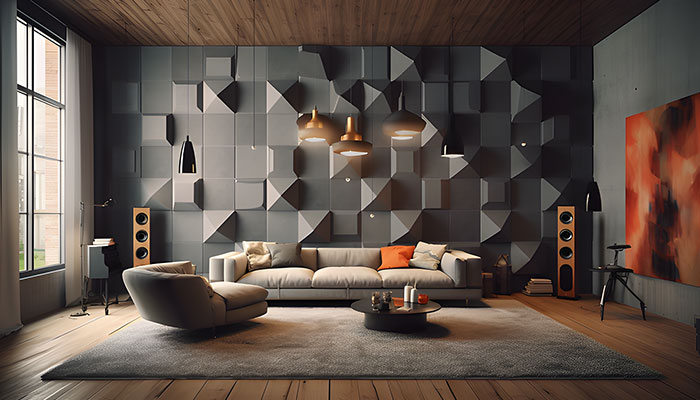Silence Spaces: Intelligent Soundproofing Solutions Saving
Whether you’re working from home, recording music, or just looking for peace, soundproofing is no longer a luxury; it’s a need for contemporary life. However, it’s crucial to know the materials for soundproofing cost before you start to work on your room. From basic acoustic panels to sophisticated insulating solutions, your choice is much shaped by the cost of the materials. This book will lead you through the elements influencing these expenses, therefore enabling you to make a wise decision without going broke.
Sort of Soundproofing Materials
The first step toward the ideal quiet space is selecting appropriate soundproofing materials. There are several choices here, each with special benefits and cost range. Popular materials include:
- Often used for homes studios and offices, acoustic foam panels are well-known for their simplicity of installation and potency. Their many forms—wedges and pyramids, among others—help to absorb sound, therefore reducing echo and noise. Usually costing less than alternative soundproofing solutions, they are also quite affordable.
- Mass Loaded Vinyl (MLV) is a first choice for people seeking great performance. Sound cannot pass through walls, flooring, or ceilings with this adaptable, weighty substance. Though somewhat more costly, its endurance and potency make it a worthy investment.

- Soundproof curtains are an excellent option if you want a quick, aesthetically acceptable fix. Perfect for bedrooms or living spaces, they provide modest sound attenuation and are somewhat reasonably priced.
- Commonly utilized in buildings, fibreglass insulation can greatly lower noise transmission. Offering both thermal and sound insulation, it’s a wonderful choice for ceilings and walls. Although the first outlay may be more, the long-term advantages usually exceed the expenditure.
Factors Influencing Soundproofing Material Cost
Several elements affect the cost of the soundproofing materials, including kind of material, quality, quantity, and installation complexity. Because of their better performance and longevity, premium materials like fibreglass insulation and MLV can cost more. Acoustic foam and soundproof curtains provide a reasonably priced alternative, nonetheless, for less demanding uses or smaller areas.
Soundproofing your area need not be unduly costly or taxing. Establishing a quieter, more pleasant surroundings starts with knowing the components for soundproofing cost. Choosing appropriate materials and managing your budget can help you to enjoy the advantages of soundproofing without sacrificing effectiveness or quality. Investing in the appropriate materials for soundproofing cost dividends in terms of peace, productivity, and privacy whether your business, house, or studio calls for it.
Elevate Your Interior Design: Exploring the Latest Innovations in Home Flooring
When it comes to interior design, flooring plays a pivotal role in setting the tone and ambiance of a space. From hardwood and tile to carpet and vinyl, there’s a wide array of flooring options available to suit every style and preference. In recent years, advancements in technology and design have ushered in a new era of innovation in home flooring, offering homeowners a plethora of exciting choices to elevate their interior design.
- Sustainable Materials:
In response to growing environmental concerns, sustainable flooring materials have gained popularity among homeowners looking to reduce their carbon footprint. Innovations in eco-friendly flooring include options such as bamboo, cork, reclaimed wood, and recycled materials. These sustainable choices not only contribute to a healthier planet but also add a touch of natural beauty and warmth to any space.
- Luxury Vinyl Tile (LVT):
Luxury vinyl tile (LVT) has emerged as a versatile and stylish flooring option that mimics the look of natural materials such as hardwood, stone, and tile. With advancements in printing and embossing technologies, LVT can replicate the texture, color, and grain patterns of real wood and stone with remarkable realism.

- Engineered Hardwood Flooring:
Engineered hardwood flooring combines the timeless beauty of natural wood with the durability and stability of engineered construction. Unlike traditional solid hardwood, engineered hardwood is composed of multiple layers of wood veneer bonded together with adhesive.
- Porcelain Tile Innovations:
Porcelain tile has long been prized for its durability and versatility, but recent innovations have taken it to new heights. Digital printing technology allows for the creation of stunning tile designs that replicate the look of natural stone, wood, concrete, and even fabric with exceptional detail and realism.
- Smart Flooring Solutions:
With the rise of smart home technology, flooring manufacturers have begun incorporating innovative features into their products to enhance functionality and convenience. Smart flooring solutions may include integrated heating systems, soundproofing properties, built-in LED lighting, and even wireless charging capabilities. These intelligent features not only improve the comfort and efficiency of a home but also add a touch of modernity and sophistication to the overall design.
The latest innovations in home flooring offer homeowners an exciting array of options to elevate their interior design and create spaces that are both beautiful and functional. Whether you’re drawn to the natural warmth of sustainable materials, the versatility of luxury vinyl tile, or the timeless elegance of engineered hardwood, there’s a flooring solution to suit every taste and lifestyle. With technology driving constant evolution in the world of flooring, the possibilities for creative expression and customization are truly endless.
